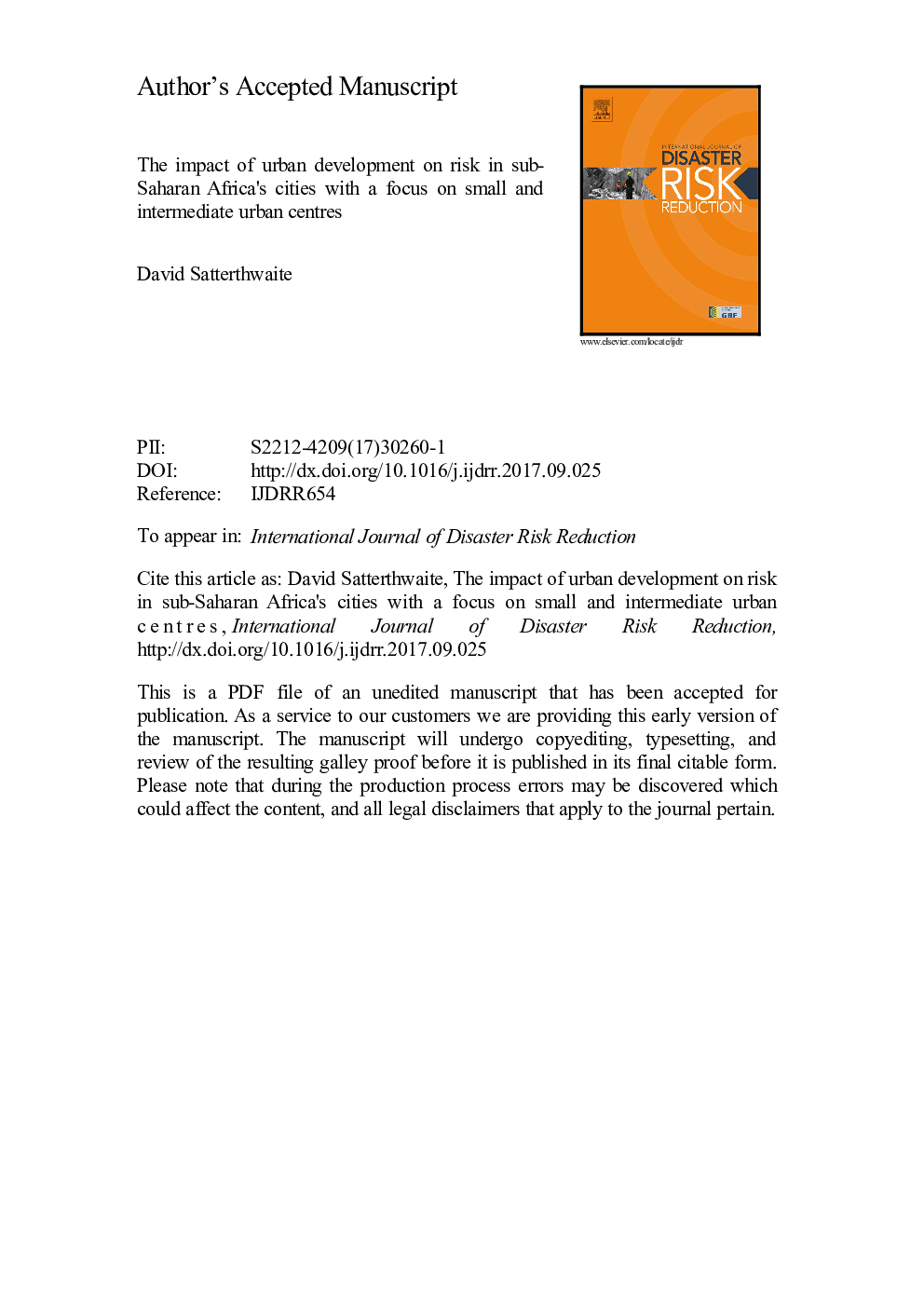| کد مقاله | کد نشریه | سال انتشار | مقاله انگلیسی | نسخه تمام متن |
|---|---|---|---|---|
| 7472113 | 1485144 | 2017 | 18 صفحه PDF | دانلود رایگان |
عنوان انگلیسی مقاله ISI
The impact of urban development on risk in sub-Saharan Africa's cities with a focus on small and intermediate urban centres
ترجمه فارسی عنوان
تأثیر توسعه شهری بر خطر در شهرهای جنوب صحرای آفریقا با توجه به مراکز کوچک و متوسط شهری
دانلود مقاله + سفارش ترجمه
دانلود مقاله ISI انگلیسی
رایگان برای ایرانیان
کلمات کلیدی
تغییر شهری، ریسک شهری، مراکز کوچک شهری، دولت محلی، زیر ساخت، خدمات،
ترجمه چکیده
مسئله اصلی شهری که در صحرای آفریقا با آن مواجه است، رشد سریع جمعیت شهری آن بدون ساختارهای حکومتی شهری است که بتواند مسئولیت های خود را بر عهده بگیرد و تغییرات را مدیریت کند. این امر نقص بسیار بزرگی در زمینه خدمات زیربنایی و خدماتی ایجاد می کند که بسیاری از جمعیت شهری را به سطوح بالای ریسک می رساند. بدون حکومت های شهری صالح و موثر و مسئول، قادر به بهره برداری از فرصت های بالقوه ای که شهرها برای حمایت از شرایط زندگی خوب و سلامت خوب می کنند، استفاده نمی شود. این مقاله، هر دو مقیاس تغییرات شهری و چالش توسعه را با چالش هایی که در مناطق شهری آفریقای جنوبی قرار دارد، بررسی می کند و پیامدهای احتمالی آن را بررسی می کند. این توصیف می کند که میزان قابل توجهی از جمعیت ملی (و شهری) در کشورهای جنوب صحرای آفریقا در مراکز شهری کوچک و متوسط (و بنابراین در مناطق روستایی یا شهرهای بزرگ) زندگی می کنند و آنچه که ما در مورد خطر در این مراکز شهری و پیامدهای آن می دانیم، برای توسعه این مقاله نشان می دهد که در جمعیت شهری منطقه، ناکافی بودن در تامین زیرساخت های اولیه و خدمات معمولا بزرگتر است، در حالی که مرکز شهری کوچکتر است. اکثر مراکز کوچک شهری در منطقه دارای دولت های محلی هستند که دارای ظرفیت یا بودجه بسیار کم برای انجام وظایف خود برای ریسک کاهش زیرساخت ها و خدمات هستند. از اینها، ناکافی بودن در تامین آب و فاضلاب بهترین توصیف شده است. اما در بعضی موارد، تأمین آب و بهداشت در شهرهای بزرگ بسیار ضعیف است، زیرا نسبت ساکنان آنها به اندازه کافی در معرض انقراض قرار دارند.
موضوعات مرتبط
مهندسی و علوم پایه
علوم زمین و سیارات
فیزیک زمین (ژئو فیزیک)
چکیده انگلیسی
The main urban issue that sub-Saharan Africa is facing is rapid growth in its urban population without the urban governance structures in place that can meet their responsibilities and manage the change. This has created very large deficits in infrastructure and service provision which exposes much of the urban population to high levels of risk. Without competent, effective and accountable urban governments, it is not possible to tap the great potential that cities have for supporting good living conditions and good health. This paper examines both the scale of urban change and the development challenge facing sub-Saharan Africa's urban areas and the possible implications on risk. It describes how a substantial proportion of sub-Saharan Africa's national (and urban) population lives in small and intermediate size urban centres (and thus not in rural areas or large cities) and considers what we know about risk in these urban centres and the implications for development. The paper suggests that within the region's urban population, inadequacies in provision for basic infrastructure and services are usually larger, the smaller the urban centre. Most small urban centres in the region have local governments with very little capacity or funding to fulfil their responsibilities for risk reducing infrastructure and services. Of these, the inadequacies in provision for water and sanitation are the best documented. But in some instances, provision for water and sanitation is so poor in large cities that the proportion of their inhabitants lacking adequate provision is as high as those living in small urban centres.
ناشر
Database: Elsevier - ScienceDirect (ساینس دایرکت)
Journal: International Journal of Disaster Risk Reduction - Volume 26, December 2017, Pages 16-23
Journal: International Journal of Disaster Risk Reduction - Volume 26, December 2017, Pages 16-23
نویسندگان
David Satterthwaite,
